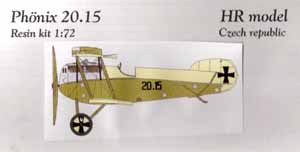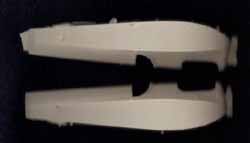HR Model 1/72 Phönix 20.15
By Michael Kendix
 |
History
The Phönix 20.15 was a World War One Austro-Hungarian prototype converted from a Hansa Brandenburg D.I 'Star Strutter', serial 28.50. The primary difference is the interplane struts, whereby the 20.15 replaced the star struts with the usual type of interplane struts: a single bay - one each side of the wing. The Phönix 20.15 was also a precursor (there was also Phönix 20.16) of the Phönix D.I/D.II/D.III series, according to the Phönix D.I/D.II Windsock Datafile, which features a couple of pictures of the 20.15. Having built the D.I, D.II and D.III, I was delighted to find a kit that would enable me to build a sequence of four, albeit in reverse chronological order
Inside the box
 This is a decent resin kit. As far as I can tell, it is what it claims, namely the Phönix 20.15 in 1/72nd scale. Upon close inspection, however, I recognized this kit fairly fast. Racing downstairs, I found my Toko Hansa Brandenburg D.I (recently re-released under the Eastern Express label) and the similarities were plain. The HR Model kit is the same as the Toko kit with a few exceptions. The fuselage, propeller, seat, instrument panel wings, tail parts, undercarriage struts and engine exhaust are identical. Not only is it from the same mold but it has the same minor flaws present in the Toko kit: the overdone fabric weave on the flying surfaces, the small flaw on the trailing port side edge of the upper wing, slight sink marks in the overhead gun and the indentation in the top wing's upper starboard side.
This is a decent resin kit. As far as I can tell, it is what it claims, namely the Phönix 20.15 in 1/72nd scale. Upon close inspection, however, I recognized this kit fairly fast. Racing downstairs, I found my Toko Hansa Brandenburg D.I (recently re-released under the Eastern Express label) and the similarities were plain. The HR Model kit is the same as the Toko kit with a few exceptions. The fuselage, propeller, seat, instrument panel wings, tail parts, undercarriage struts and engine exhaust are identical. Not only is it from the same mold but it has the same minor flaws present in the Toko kit: the overdone fabric weave on the flying surfaces, the small flaw on the trailing port side edge of the upper wing, slight sink marks in the overhead gun and the indentation in the top wing's upper starboard side.
 There are a few differences. The HR Model kit has regular interplane struts instead of star struts, an extra set of cabane struts, a floor piece and a decent complete engine. The Toko D.I only has the top part of the engine though it can be built with the engine covered, depending upon which aeroplane you make: pictures of the 20.15 show an uncovered engine. The wheels are slightly different. The HR Model kit does not contain the support behind the pilot's seat, nor does it have the control stick and foot rudder. The decals are different: HR Model's kit does not contain the wood grain decals and obviously it does not require the Brumowski Distribution swirls.
There are a few differences. The HR Model kit has regular interplane struts instead of star struts, an extra set of cabane struts, a floor piece and a decent complete engine. The Toko D.I only has the top part of the engine though it can be built with the engine covered, depending upon which aeroplane you make: pictures of the 20.15 show an uncovered engine. The wheels are slightly different. The HR Model kit does not contain the support behind the pilot's seat, nor does it have the control stick and foot rudder. The decals are different: HR Model's kit does not contain the wood grain decals and obviously it does not require the Brumowski Distribution swirls.
The HR Model's kit contains some background information on the aeroplane and some scale drawings. There are no other instructions for building the kit; of course, you can always use the Toko instructions.
Conclusion
The HR Model Phönix 20.15 cost me $14.95, which is a bargain compared to some of the prices quoted by various vendors. However, I can buy an Eastern Express Hansa Brandenburg D.I for less than half the money, and replace the star struts with regular interplane struts - they are 2.1cm long according to the 1/72nd scale diagram in the HR Model's kit. In addition, I prefer building injection molded plastic because I usually replace all resin kits' struts, such as the undercarriage, for fear that the structural support resin parts will bend.
HR Model has used the Toko mold to produce a variant of the D.I kit. Do yourself a favour: unless you are incapable of making four 2.1cm struts, buy the Eastern Express Hansa Brandenburg D.I and build the easiest conversion of your life.
Reference
-
Peter M. Grosz "Phönix D.I-II: Windsock Datafile 31." Albatros Publications, Ltd., Berkhamsted, Herts., U.K., 1992.
